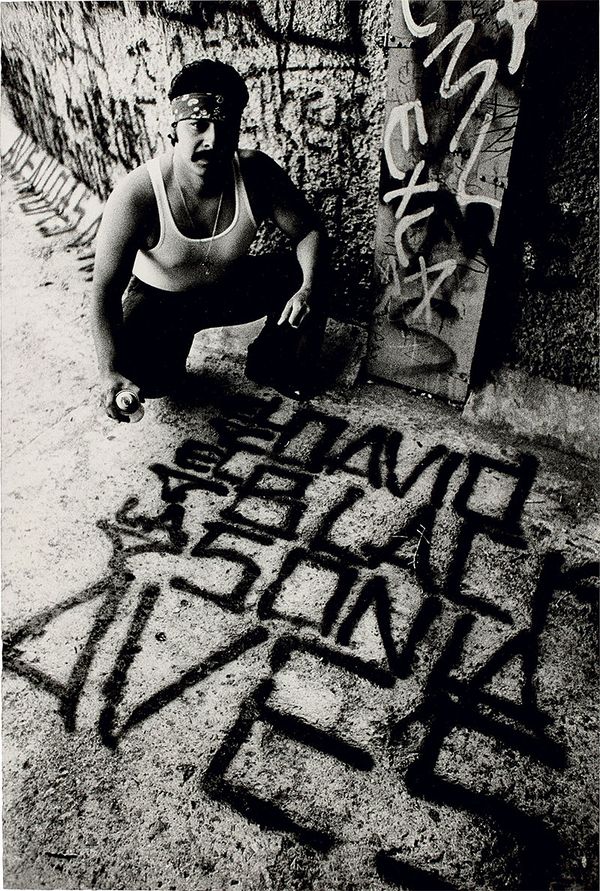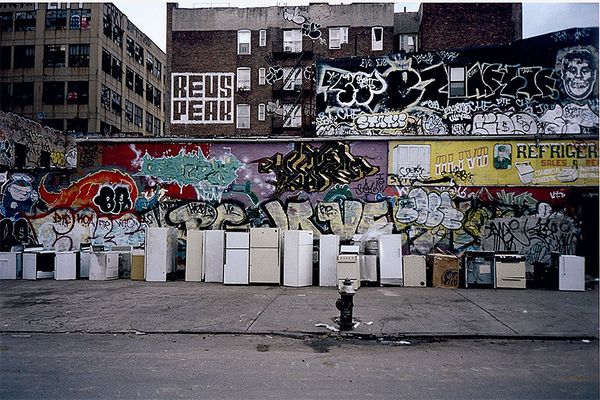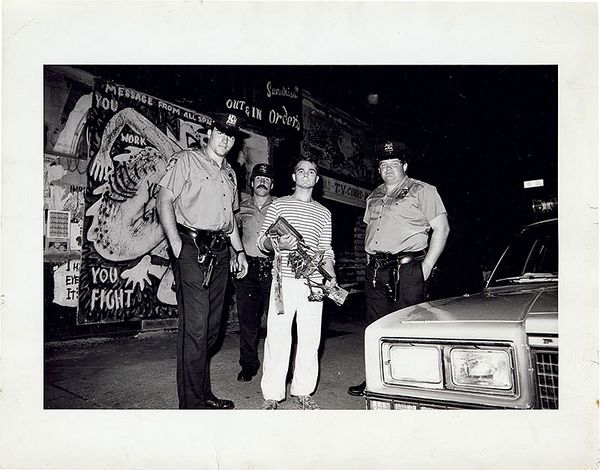Perhaps one of the most immediately discernible differences between graffiti and more traditional forms of art is that unlike a painting, the work of street art makes no gesture towards longevity. Graffiti is an inherently fleeting mode of artistic expression. Whether it lasts one night before being painted over or a month before the brick façade is destroyed, it takes documentation for a work to pass from ephemera to icon. Thankfully, an incredible array of photographers and writers, often working with the artists themselves, have preserved these works for their rightful place in art history. In conjunction with the 1970s / GRAFFITI / TODAY exhibition now on view at Phillips through 20 February, we highlight the books and stories that showcase the history and ethos of graffiti.

Gusmano Cesaretti, David, Avenue 43, Highland Park, 1973. 1970s / GRAFFITI / TODAY.
Chapter 1: First Steps
Gusmano Cesaretti, Street Writers: A Guided Tour of Chicano Graffiti (1975)
Cesaretti’s 1975 book of photographs was the first to document Chicano culture through the perspective of its artistic output. Rendered in beautiful black and white, his images tell the story of the barrio, its residents, and the myriad ways in which graffiti signaled location and identity in 1970s Los Angeles, with pioneering works by the “Godfather of Los Angeles Graffiti” Chaz Bojórquez. Recently re-released, the book’s all-black cover stands out today just as it did over half a century ago, and its images are as stark as ever.
Martha Cooper & Henry Chalfant, Subway Art (1984)
Another book which has been recently republished, Subway Art “brought graffiti to the world” in its original 1984 iteration, documenting the fledgling artistic movement in New York with unprecedented access to artists and now-historical photographs of some of the era’s most influential works. Today the book is still far from a relic, as Cooper and Chalfant attest in new afterwards, with the decline of subway graffiti in the 1980s and 90s, instead going above ground and growing into a global phenomenon.

Cheryl Dunn, REVS Peak Refrigerators, Williamsburg, 1998. 1970s / GRAFFITI / TODAY.
Chapter 2: Know Your Tags
Rafael Schacter, The World Atlas of Street Art and Graffiti (2013)
Schacter’s globe-spanning survey of the form is a perfect starting point for familiarizing yourself with the key names and movements in the development and contemporary world of graffiti. The book connects history, architecture, topography, and art to find transnational links in the urban experience, with graffiti as the creative adhesive between them all. Public spaces, Schacter shows, are transient zones made permanent by graffiti and the artists who interpret them.
Roger Gastman & Caleb Neelon, The History of American Graffiti (2010)
It can be hard to realize – especially from the detached context of the present – just how much youthful exuberance factored into the early days of graffiti, as Gastman and Neelon’s book highlights. Teenage taggers themselves who grew up to become gallerists and educators, the authors trace key works in the form to high school students making rebellious gestures on city walls and public transit, as well as establishing an archival base of thousands of interviews and photographs for this extensively thorough account of graffiti’s growing pains and maturity.

Linus Coraggio, “Untitled,” June 1984 Linus holding a 3D graffiti piece with police (NE corner Ave B and 10th St), 1989. 1970s / GRAFFITI / TODAY.
Chapter 3: Graffiti in the Era of Broken Windows Policing
Don DeLillo, "The Angel Esmarelda" (1994)
Known for his sprawling novels, DeLillo’s short story pares back the author’s indelible storytelling through an in-and-out narrative akin to a graffiti artist sneaking onto an empty lot before the cops arrive. In the “killing streets” of the South Bronx, where graffiti tags memorialize children who’ve faced fates like "left in dumpster, forgot in car, left in Glad bag Xmas Eve," a young girl appears in the rubble of the abandoned lots, escaping the attempts of nuns seeking to offer charity. When her name joins the others on the memorial, an apparition of the girl mysteriously appears on an orange juice billboard on the side of the highway, drawing partitioners to witness a possible miracle.
Susan A. Phillips, Wallbangin: Gangs and Graffiti in L.A. (1999)
Anthropologist Susan A. Phillips takes an expansive view of Los Angeles gang graffiti at the height of the “gangster” era, when street culture – and, by extension, graffiti – became shorthand for urban decay and the moral rot at the end of history. Phillips decrypts the visual language of graffiti in this environment to reveal a complex, evolving lexicon of signifiers and narratives, one of memorials, territory, politics, race, and a means through which the marginalized residents of Los Angeles maneuver and keep pace with the ever-shifting urban landscape of the city.

Mr Cartoon, My Hood, 2007. 1970s / GRAFFITI / TODAY.
Chapter 4: These Weren’t Always Condos: Graffiti & Contemporary Space
Jonathan Lethem, The Fortress of Solitude (2003)
It was just called Gowanus before developers carved out a section of rowhouses to call Boerum hill. Lethem’s coming of age novel tells the story of the memories that bind disparate friends to their old neighborhood, with graffiti as a stand-in for the authentic details of the street before it underwent a real estate boom, as well as the ways in which identify forms through artistic expression.
Gregory J. Snyder, Graffiti Lives: Beyond the Tag in New York’s Urban Underground (2009)
Forget fly-on-the-wall accounts – Snyder’s decade-long study of contemporary graffiti culture puts the art side by side with sports and logistics. The sociologist follows artists as they plan spray-paint heists, scale buildings, run through lots, hop fences, and catwalk around ledges to gain entry to ideal spots, only to scramble and run from the police before finding another place to work. This is the new generation of graffiti artists, not necessarily bound by neighborhood or background, but by a shared love of the form and a palpable dedication to perfecting it.
Discover More from 1970s / GRAFFITI / TODAY_>
Recommended Reading
1970s / GRAFFITI / TODAY: The Primer >
Phillips 2021: Your Favorites >
